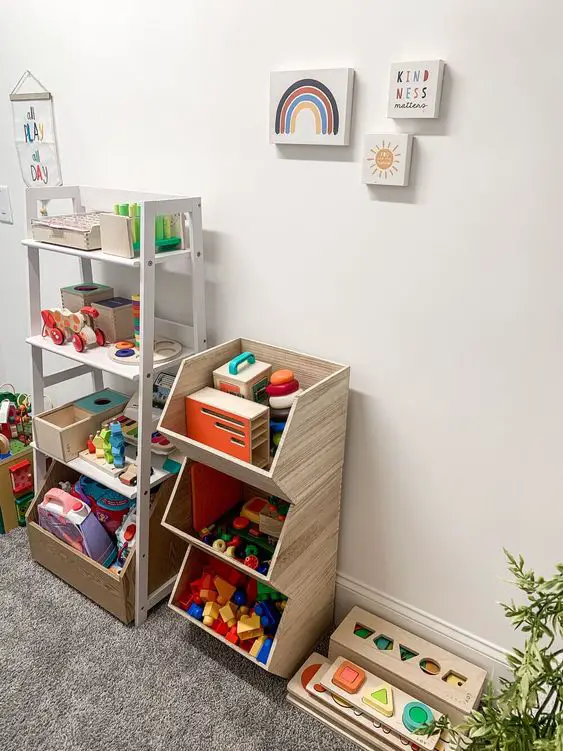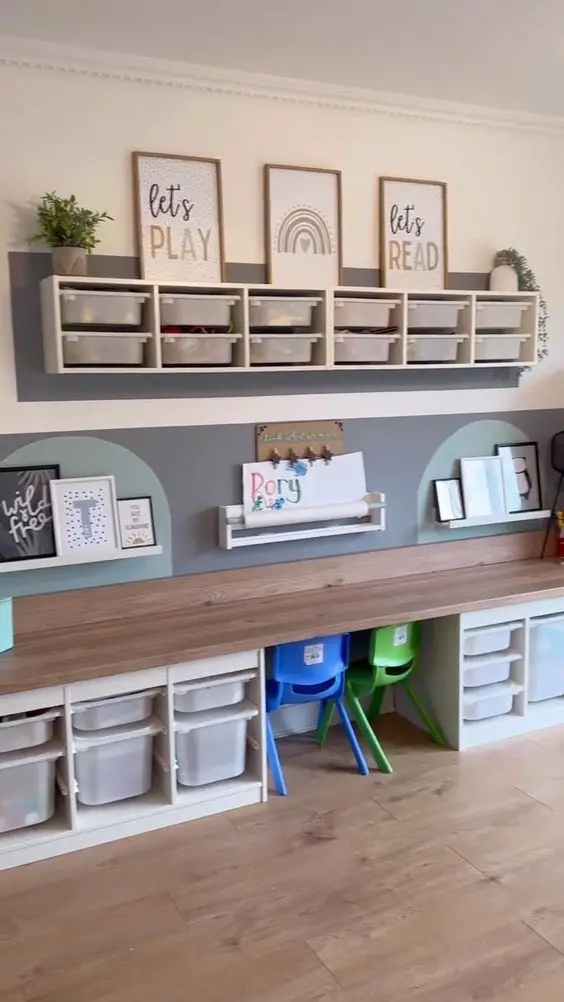Creating a harmonious and functional space for children to play and learn is an art that combines interior design with the imaginative world of little ones. The challenge becomes even more intriguing when the space is limited. This article delves into the realm of kids’ toy organization in small spaces, bringing forth innovative and stylish solutions that transform chaos into order. By integrating the latest design trends with practical storage solutions, parents can craft a space that not only looks good but also encourages kids to take part in tidying up after playtime.
Creative Utilization of Vertical Spaces
Imagine transforming a blank wall into a haven for play and learning. Shelves mounted above a simple white bench provide a home for neatly labeled bins, with clear fronts to display the colorful contents within. This vertical approach maximizes floor space while maintaining an airy feel. The use of natural wood tones for labels adds a touch of warmth, making the space inviting. It’s a testament to the Scandinavian design principle of form meeting function, where the uncluttered aesthetic promotes calm and focus for young minds.

Bright and Open Toy Display
Here we see a vibrant and open display of toys, where each item is easily accessible. This method embraces the Montessori philosophy of encouraging independence by keeping toys at a child’s height. The clear bins and bright labeling system make it easy for little ones to find and return their treasures. This storage idea is a perfect example of how minimalism in design can lead to a more meaningful playtime, eliminating the overwhelming clutter that often hinders creativity.

Hidden Storage in Plain Sight
In this space, we notice a clever use of dual-purpose furniture. A white storage unit with both open and closed compartments allows for a mix of display and concealed storage. Woven baskets bring in texture and a natural element that contrasts beautifully with the clean lines of the furniture. This design reflects the popular trend of ‘hidden storage’ where the room maintains its stylish aesthetic while providing ample space for toys.

Nooks of Joyful Learning
Utilizing corners and nooks can turn an unused space into a joyful learning corner. Wall-mounted shelves with playful decor and educational toys encourage a love for reading and creativity. The combination of open and closed storage encourages kids to engage with their environment. This picture captures the essence of a modern learning space that is both functional and decorative, embodying the principles of educational design within the home.

Plush Comfort with Organized Charm
There’s a cozy corner that invites children to dive into the world of stories with plush pillows and a low-lying bookshelf. Above, a clean white shelf holds an array of books, their spines adding a splash of color to the neutral palette of the room. The use of soft textures and the strategic placement of reading materials at a child’s reach suggest a design that understands the importance of comfort in cultivating a love for reading.

A Blend of Play and Learning
This image showcases a perfect blend of play and learning, where toys and books coexist harmoniously. The clever use of labels and bins ensures that each item has its place, instilling organizational habits from a young age. The design speaks to a contemporary trend of multi-functional spaces where children can both learn and play, reflecting a balanced approach to childhood development.

Sleek and Modern Toy Storage
The sleek lines of modern furniture design are evident here, where a combination of open and closed storage is seamlessly integrated into the room. The subtle color palette is punctuated by toys and books, which act as functional decor. This image is a nod to modern interior design, where simplicity and practicality go hand in hand.

Whimsical and Practical Storage Solutions
Whimsy meets practicality in this delightful storage solution. Wall-mounted boxes with clear fronts make it easy for kids to see and choose their toys, while lower bins provide quick clean-up options. This design is a playful take on the ‘less is more’ philosophy, encouraging kids to value their playthings by making each one easily accessible and visible.

A Room that Grows with the Child
This room is a testament to thoughtful design that grows with the child. Shelves at varying heights offer space for both current favorites and those to come. The use of bright colors and natural materials like wood and wicker adds a timeless quality, ensuring the room remains relevant and engaging as the child matures.

Seamless Integration of Play and Life
The final image embodies a seamless integration of play into the fabric of everyday life. Here, a bookshelf isn’t just a place for storage; it’s a gallery of memories and learning. The addition of personal touches, like framed photographs and cherished toys, gives the room a lived-in feel that’s both personal and stylish.

In conclusion, this exploration of kids’ toy organization in small spaces has unveiled a myriad of innovative and stylish solutions that serve more than just a functional purpose. Each idea presented reflects a deep understanding of the importance of creating spaces that are not only aesthetically pleasing but also conducive to a child’s growth and development.
The creative use of vertical spaces, bright and open toy displays, hidden storage options, and the transformation of nooks into joyful learning corners all speak to a thoughtful approach in interior design. These solutions show that limited space does not mean compromising on style or functionality. Instead, it offers an opportunity to think creatively and make every inch count.
Moreover, these designs foster a sense of independence and responsibility in children, encouraging them to take part in tidying up and caring for their environment. From plush corners designed for reading to sleek, modern storage solutions, each setup has been crafted with the child’s needs and interests in mind.
The blend of play and learning, the incorporation of whimsical yet practical storage solutions, and the consideration for a room that grows with the child, all highlight a forward-thinking approach to interior design for kids’ spaces. It’s about creating an environment that nurtures creativity, learning, and growth, while also being a delightful and harmonious part of the home.
Ultimately, these ideas prove that even in small spaces, with thoughtful design and clever storage solutions, you can create a magical and functional world for children to thrive in.


